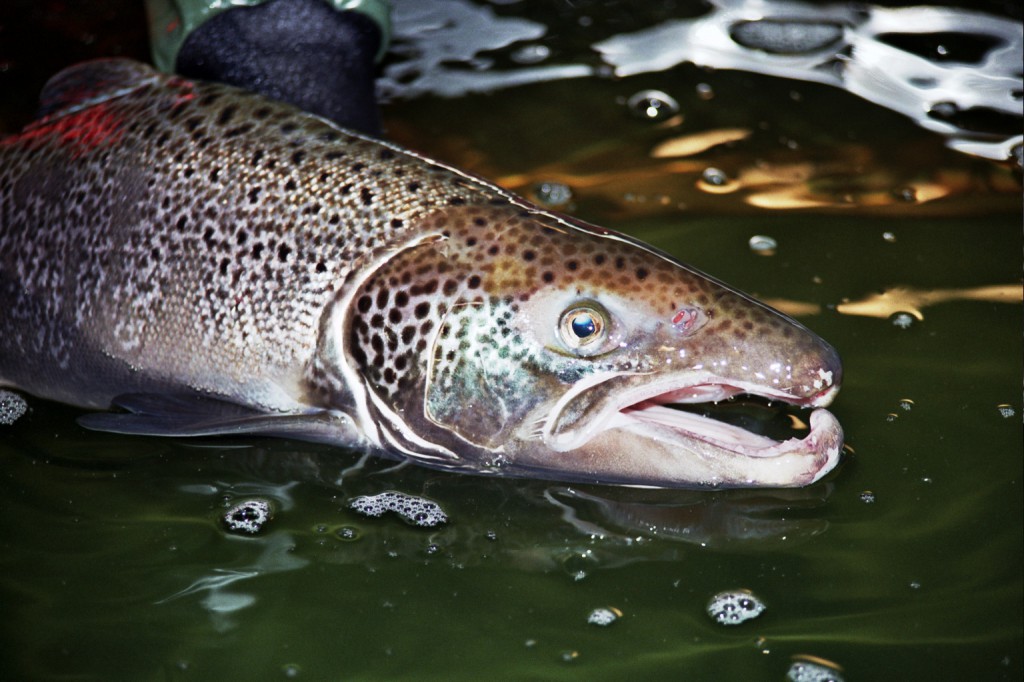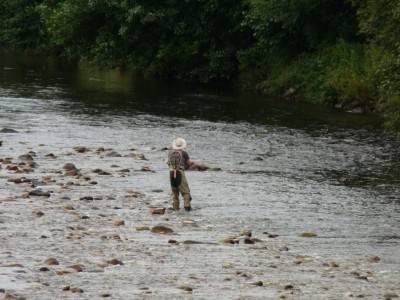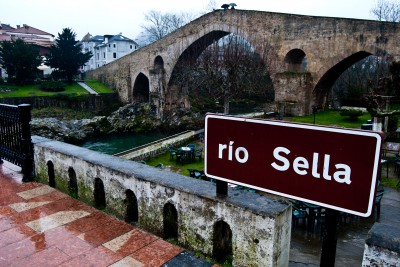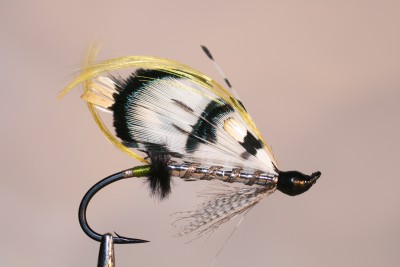Far from his sunny paradise image and topics like the siesta, Spain hoards a geography so varied that includes a green and wet north territory where some of the salmon rivers that time ago were among the best in Europe. Probably his richness already is not so spectacular but the fishing continues being an international claim.
Without scarcely notice it, we take two bottles of natural cider consumed in a brief lapse of time in which we have decided to leave the rods to have lunch a little. It looks like a chance, but I realize that in Europe, all important salmon places are tied from another way to a drink. It happens in Ireland with the Guiness, in Scotland with the whiskey and here, in the north of Spain, with the cider, a fundamental drink of the popular culture.
Lucky, the fishing of salmon in this country is so deep-rooted and is so popular, that the places where it is practised are not far from any side, and the roads, the hotels and the tapas bars where to consume any lids (snacks) are close to of river, which allows to bring together fishing and tourism of a very interesting way.
Thant´s the north of Spain, a zone where last salmons of the map in south direction are located (we do not count with introduced in South America) and where the green color is greener than any other place in the continent. A land of rains, Celts and witches that along the history has tried to support and to protect the fishing of the salmon as a cultural patrimony that though it does not pass for his better moments, as in the rest of the world, deserves the visit of every fan of the Salmo salar who wants to live the experience of capturing the king of the river in a different country from traditional circuits of salmon fishing.
Where and how to fish salmons
In adition of “classics” of what Spain is – sun and beach- there are places around the country with different weather and ecologic conditions wich allow the atlantic salmon to live in a dozen of good rivers that in the early century where almost fifty. Salmon fishing in Spain has added value of being in the southest part of the world of his original habitat, so that makes much more interesting for the fisherman the trip.

Male atlantic salmon.
You can find the king of the river just in the north in the country, in the rivers wich flow on the Cantabric sea all around the coast from french frontier to portuguese one, but not all one are good for fishing, and reaching licenses, good beats and useful information about salmon entrances means a little of knowledge and some prevision.
Asturias, Galicia and Cantabria are the regions that may be searched in the map to find the best casts and the biggest numbers of captures in the annual statistic.
Native people usually say that salmon fishing in Spain is different, and they have some arguments and reasons to confirm it. One of the characteristic is the short length of them. The proximity of big mountains to the cost, where all rivers are borned makes a less than 100 km live of most the cases, with an upstream very narrow and a salmon section very closed to the see that rarely passes of 20-30 km where the fishing beat and free parts of the rivers are concentred.
So, you can find it in reasonably touristic areas that quits some adventure interest for extreme anglers, but gives a extra quality if you are looking for other things fishing apart, like good gastronomy, excellent communications by road and the attractive way of living of rural traditional villages of northern Spain. That makes also a special way of fishing based on the pools and not so much in the streams, so it can be considered quite static but more effective in fact.
Also traditional are the types of fishing of native anglers. As in all the salmon rivers of the world, fly fishing and some spin techniques have been implanted and are used, but live bait is considered the best way of catching salmon. A trifle or prawn, put in a big hook and moved in the pools by rods of 9-11 meters and bait casting reels obtains about 80% of salmons.
That makes the system almost exclusive of the country. It works like the nymph fly fishing: from an elevated position, angler puts a convenient plumbed line tippet of prawn as near as he can at the begging of the pool and leaves it go downstream with extremely delicacy to the end of that. Good sensibility and hability to “read” the rivers are qualities necessary for the success. Variation and tuning of prawn baits are frequent, finding them in different presentation as raw, boiled or stained in red or blue colors to attract fishes. A special combination of prawn and worm known as “mixed sandwich” can be seen in most of the shores.
Spinning and flyfishing for salmon
Spinning is also used during the first weeks of the seasons. Rivers like those, with an accentuated fluctuation of water between spring and summer allows a short time to move spinners, minnows and the local bait called “devon” in the spots, so it is indicated during the opening. It means march, april and mid may months, always depending of water levels and local laws which are not very simple in fact for a foreign anglers: fishing rules information is the most important thing to obtain before going to the river.
In the other hand, fly fishing gives a better opportunity to try all over the season. In some parts like Asturias, this type is older in fact than bait fishing, but salmon decreases caused people change habits, now again driving trough the fly technique as the most sportive and consistent with the salmon population.
Hair patters as the Cascades or Hairy Mairy obviously work in Spanish rivers, but you don´t have to waste the opportunity of try with classic Spanish world famous hair flies made by the XX century tier Belarmino Martínez. Find his own models as the River Pas, River Esva or Silver Martínez is easy on the local fishing shops or the Internet. Belarmino was proposed by Hardy to manage a fly fishing factory in England in the 60s. His love to his land and spanish rivers made him to reject the offer.
Sella and Narcea: the two jewels of Asturias
The Sella is the most productive river during the last years. Although you can not expect such weigths and number of fishes as in Norway or Kola peninsula, fishing in the right days with good water condition can be enough to have success. Recent statistics have let a total of 800-1.000 salmons for season, having a record of 2.871 fishes in 1959 that at the moment are difficult to reach.

River Narcea, best salmon fishery in Spain.
In this river and the rest of them of Asturias county, season goes from mid march to the end of july, with a special period until september only for fly fishing. It has more than 15 different beats and some niece free zones where you can go without paying the permit, only the license (in Spain you have a license for each county, about 10 euros).
In case you want to ask for the beats, there is a complicated system to obtain it: first you have to send the application on September and wait for the draw where Administration will give you a number. Months after, in January, first number in choosing beats is published and fisherman can ask for his choice. Not very useful, slow and far from reasonably in the XXI century, but that´s how it works. Of course, there are possibilities to fish in not occupied beats during the season, spacially if you want to do it out of weekend and best dates (june and july).
River Narcea is the second recommendation to a fishing trip in Spain. As Sella, you can find it near the cities of Gijon and Oviedo, capital of Asturias county and famous for its rain, the historic heritage of prerromanic art and his cider, three of the main things you wont´t loose in the north of Spain. This 102 km river is the longest salmon river, divided in both beats and free fishing zones and with a deserved fame during the 80s and 90s, when thousands of tourist came to visit some spectacular beats as Las Mestas (a few center of meters) where fishing 180 salmon per seasons was possible.
But if you are unable to get those rivers, same license for Asturias is valid for another four rivers where salmon returns in different number of fishes. River Eo has a 28 km stretch flowing probably in the most beautiful landscapes of the north. This is considered the earlier river because his clear and turquoise water are warmer than the rest; that makes that salmon in march and april –the biggest ones- are often. The problem is the short free strecht of the river: just a few km in the zone known as “Xesteira”. Close to this one you can find Esva and Porcia rivers nice spots but with limited fishing potential, as Navia, all of them in west Asturias.


 May marks the beginning of fishing in Galicia with the same procedure of licenses mentioned before. Except the Eo (wich is shared with Asturias) no one of these river can be considered in the top 5 of spanish salmon, but a shorter season gives much opportunity. River Ulla is the most plentiful one of them. A 132 km water line with three important beats (Sinde, Couso and Ximonde) with better options for live bait and spoon anglers baceuse we are talking about a huge river where you can´t wade easily. So fly fishing is reserved for braves.
May marks the beginning of fishing in Galicia with the same procedure of licenses mentioned before. Except the Eo (wich is shared with Asturias) no one of these river can be considered in the top 5 of spanish salmon, but a shorter season gives much opportunity. River Ulla is the most plentiful one of them. A 132 km water line with three important beats (Sinde, Couso and Ximonde) with better options for live bait and spoon anglers baceuse we are talking about a huge river where you can´t wade easily. So fly fishing is reserved for braves. The season therefore is similar to the rest of Europa talking about entry of salmons. The first ones, during March are undoubtedly the biggest, but also more scanty ones, reaching weight of up to 10 kilos.
The season therefore is similar to the rest of Europa talking about entry of salmons. The first ones, during March are undoubtedly the biggest, but also more scanty ones, reaching weight of up to 10 kilos.
Deja una respuesta